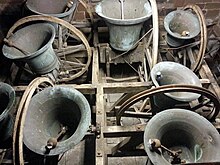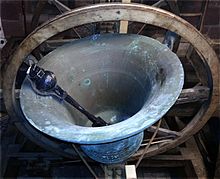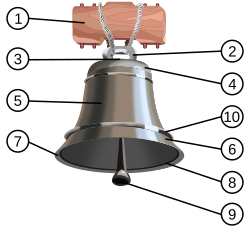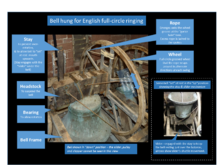Church bell

A church bell in the Christian tradition is a bell which is rung in a church for a variety of church purposes, and can be heard outside the building. Traditionally they were used to call worshippers to the church for a communal service, and to announce times of daily prayer, called the canonical hours. They are also rung on special occasions such as a wedding, or a funeral service. In some religious traditions they are used within the liturgy of the church service to signify to people that a particular part of the service has been reached.[1][1] The ringing of church bells, in the Christian tradition, was also believed to drive out demons.[2][3]
The traditional European church bell (see cutaway drawing) used in Christian churches worldwide consists of a cup-shaped metal resonator with a pivoted clapper hanging inside which strikes the sides when the bell is swung. It is hung within a steeple or belltower of a church or religious building,[4] so the sound can reach a wide area. Such bells are either fixed in position ("hung dead") or hung from a pivoted beam (the "headstock") so they can swing to and fro. A rope hangs from a lever or wheel attached to the headstock, and when the bell ringer pulls on the rope the bell swings back and forth and the clapper hits the inside, sounding the bell. Bells that are hung dead are normally sounded by hitting the sound bow with a hammer or occasionally by a rope which pulls the internal clapper against the bell.
A church may have a single bell, or a collection of bells which are tuned to a common scale. They may be stationary and chimed, rung randomly by swinging through a small arc, or swung through a full circle to enable the high degree of control of English change ringing.
Before modern communications, church bells were a common way to call the community together for all purposes, both sacred and secular.
Uses and traditions
Call to prayer
In Christianity, some Anglican, Catholic, and Lutheran churches ring their church bells from belltowers three times a day, at 6:00 a.m., 12:00 p.m. and 6:00 p.m., summoning the Christian faithful to recite the Lord’s Prayer,[5][6][7] or the Angelus, a prayer recited in honour of the Incarnation of God.[8][9]

The injunction to pray the Lord's prayer thrice daily was given in Didache 8, 2 f.,[10][11] which, in turn, was influenced by the Jewish practice of praying thrice daily found in the Old Testament, specifically in Psalm 55:17, which suggests "evening and morning and at noon," and Daniel 6:10, in which Daniel prays thrice a day.[10][11][12] As such, the Catechism of the Catholic Church states that the Early Church prayed the Lord's Prayer thrice a day, supplanting the former Amidah predominant in the Hebrew tradition.[13] In the Book of Common Prayer, the Daily Office, which is central to Anglican spirituality, also includes the Lord's Prayer, along with "a selection from the Psalter, readings from the Holy Scriptures, [and] one or more canticles."[14]
Some Protestant Churches ring church bells during the congregational recitation of the Lord's Prayer, after the sermon, in order to alert those who are unable to be present to "unite themselves in spirit with the congregation."[15][16]
In many historic Christian Churches, church bells are also rung on All Hallows' Eve,[17] as well as during the processions of Candlemas and Palm Sunday;[18] the only time of the Christian Year when church bells are not rung include Maundy Thursday through the Easter Vigil.[19] The Christian tradition of the ringing of church bells from a belltower is analogous to the Islamic tradition of the adhan from a minaret.[20][21]
Call to worship
Most Christian denominations ring church bells to call the faithful to worship, signalling the start of a mass or service of worship.[15][22]

In the United Kingdom predominantly in the Anglican church, there is a strong tradition of change ringing on full-circle tower bells for about half an hour before a service. This originated from the early 17th century when bell ringers found that swinging a bell through a large arc gave more control over the time between successive strikes of the clapper. This culminated in ringing bells through a full circle, which let ringers easily produce different striking sequences; known as changes.
Exorcism of demons
In Christianity, the ringing of church bells was traditionally believed to drive out demons and other unclean spirits.[2][23] Inscriptions on church bells relating to this purpose of church bells, as well as the purpose of serving as a call to prayer and worship, were customary, for example "the sound of this bell vanquishes tempests, repels demons, and summons men".[3] Some churches have several bells with the justification that "the more bells a church had, the more loudly they rang, and the greater the distance over which they could be heard, the less likely it was that evil forces would trouble the parish."[23]
Funeral and memorial ringing

The ringing of a church bell in the English tradition to announce a death is called a death knell. The pattern of striking depended on the person who had died; for example in the counties of Kent and Surrey in England it was customary to ring three times three strokes for a man and two times three for a woman, and one times three for a child. The age of the deceased was then rung out. In small settlements this could effectively identify who had just died.[24]
There were three occasions surrounding a death when bells could be rung. There was the "Passing Bell" to warn of impending death, the second the Death Knell to announce the death, and the last was the "Lych Bell", or "Corpse Bell" which was rung at the funeral as the procession approached the church.[25] This latter is known today as the Funeral toll.
A more modern tradition where there are full-circle bells is to use "half-muffles" when sounding one bell as a tolled bell, or all the bells in change-ringing. This means a leather muffle is placed on the clapper of each bell so that there is a loud "open" strike followed by a muffled strike, which has a very sonorous and mournful effect.
Sanctus Bells

The term "Sanctus bell" traditionally referred to a bell suspended in a bell-cot at the apex of the nave roof, over the chancel arch, or hung in the church tower, in medieval churches. This bell was rung at the singing of the Sanctus and again at the elevation (liturgy) of the elements, to indicate to those not present in the building that the moment of consecration had been reached. The practice and the term remain in common use in many Anglican churches.
Within the body of a church the function of a sanctus bell can also be performed by a small hand bell or set of such bells (called altar bells rung shortly before the consecration of the bread and wine into the Body and Blood of Christ and again when the consecrated elements are shown to the people.[26] Sacring rings or "Gloria wheels" are commonly used in Catholic Churches in Spain and its former colonies for this purpose.[27]
Orthodox Church
In the Eastern Orthodox Church there is a long and complex history of bell ringing, with particular bells being rung in particular ways to signify different parts of the divine services, Funeral tolls, etc. This custom is particularly sophisticated in the Russian Orthodox Church. Russian bells are usually stationary, and are sounded by pulling on a rope that is attached to the clapper so that it will strike the inside of the bell.
Other uses
Clock chimes
Some churches have a clock chime which uses a turret clock to broadcast the time by striking the hours and sometimes the quarters. A well-known musical striking pattern is the Westminster Quarters. This is only done when the bells are stationary, and the clock mechanism actuates hammers striking on the outside of the sound-bows of the bells. In the cases of bells which are normally swung for other ringing, there is a manual lock-out mechanism which prevents the hammers from operating whilst the bells are being rung.
Warning of invasion
In World War II in Great Britain, all church bells were silenced, to ring only to inform of an invasion by enemy troops.[28]
Design and ringing technique
 Parts of a typical tower bell hung for swinging: 1. yoke, or headstock 2. canons, 3. crown, 4. shoulder, 5. waist, 6. sound bow, 7. lip, 8. mouth, 9. clapper, 10. bead line |

Christian church bells have the form of a cup-shaped cast metal resonator with a flared thickened rim, and a pivoted clapper hanging from its centre inside. It is usually mounted high in a bell tower on top of the church, so it can be heard by the surrounding community. The bell is suspended from a headstock which can swing on bearings. A rope is tied to a wheel or lever on the headstock, and hangs down to the bell ringer. To ring the bell, the ringer pulls on the rope, swinging the bell. The motion causes the clapper to strike the inside of the bell rim as it swings, thereby sounding the bell. Some bells have full-circle wheels, which is used to swing the bell through a larger arc, such as in the United Kingdom where full- circle ringing is practised.
Bells which are not swung are "chimed", which means they are struck by an external hammer, or by a rope attached to the internal clapper, which is the tradition in Russia.
Blessing of bells
In some churches, bells are often blessed before they are hung.
In the Roman Catholic Church the name Baptism of Bells has been given to the ceremonial blessing of church bells, at least in France, since the eleventh century. It is derived from the washing of the bell with holy water by the bishop, before he anoints it with the "oil of the infirm" without and with chrism within; a fuming censer is placed under it and the bishop prays that these sacramentals of the Church may, at the sound of the bell, put the demons to flight, protect from storms, and call the faithful to prayer.
History
In AD 400, Paulinus of Nola introduced church bells into the Christian Church.[29][30] In AD 604, Pope Sabinian officially sanctioned their usage.[30][31] By the early Middle Ages, church bells became common in Europe.[32] They were first common in northern Europe, reflecting Celtic influence, especially that of Irish missionaries.[32] Before the use of church bells, Greek monasteries would ring a flat metal plate (see semantron) to announce services.[32] The signa and campanae used to announce services before Irish influence may have been flat plates like the semantron rather than bells.[32] The oldest surviving circle of bells in Great Britain is housed in St Lawrence Church, Ipswich.[33]
Image gallery
-
Lullusglocke, cast in 1038, in monastery of Bad Hersfeld in Hesse, Germany
-
Sigismund Bell in Kraków, Poland, cast in 1520 by Hans Beham
-
Pummerin in Stephansdom, Vienna
-
Tsar Bell in Moscow, Russia, the heaviest existing bell in the world (over 196 tons)
-
Belgian-made bell of St. Xavier's Church, Peyad, Trivandrum, Kerala, India
-
Bell in the Cathedral Church of Saint Matthew, Dallas, Texas
-
Bell in Cologne Cathedral
-
Bell for San Miguel Mission
-
Ringing the bells at Ipatiev Monastery in Kostroma, Russia.
-
Ring of eight bells in the tower of St Michael and All Angels' parish church, Blewbury, Oxfordshire
See also
- Handbells
- Bells
- Bellfounding
- Campanology
- Central Council of Church Bell Ringers
- Change ringing
- Veronese bellringing art
- Loudspeakers in mosques
- Russian Orthodox bell ringing
- Bolognese bell ringing art
- Ring of bells
References
- ^ a b Church Words: Origins and Meanings. Forward Movement. 1 August 1996. Retrieved 16 August 2012.
There are two sorts of liturgical bells in the history of the Christian Church-church bells in spires or towers used to call the faithful to worship, and sanctuary bells used to call attention to the coming of Christ in the Holy Eucharist.
- ^ a b Booth, Mark (11 February 2014). The Sacred History: How Angels, Mystics and Higher Intelligence Made Our World. Simon and Schuster. p. 274. ISBN 9781451698589.
Church bells would be rung to drive away demons.
- ^ a b Cohen, I. Bernard (1990). Benjamin Franklin's Science. Harvard University Press. p. 119. ISBN 9780674066595.
The practice of ringing church bells to dissipate lightning storms and prevent their deleterious effects had a long tradition in Europe and had been a concomitant to the general belief in the diabolical agency manifested in storms. ... Typical inscriptions on church bells described their powr to "ward off lightning and malignant demons"; stated that "the sound of this bell vanquishes tempests, repels demons, and summons men," or exhorted it to "praise God, put to flight the coulds, affright the demons, and call the people"; or noted hat "it is I who dissipate the thunders."
- ^ Adato, Joseph; Judy, George. The Percussionist's Dictionary. Alfred Music. p. 11. ISBN 9781457493829.
- ^ George Herbert Dryer (1897). History of the Christian Church. Curts & Jennings.
…every church-bell in Christendom to be tolled three times a day, and all Christians to repeat Pater Nosters (The Lord's Prayer)
{{cite book}}:|access-date=requires|url=(help) - ^ Joan Huyser-Honig (2006). "Uncovering the Blessing of Fixed-Hour Prayer". Calvin Institute of Christian Worship.
Early Christians prayed the Lord's Prayer three times a day. Medieval church bells called people to common prayer.
{{cite web}}:|access-date=requires|url=(help); Missing or empty|url=(help) - ^ Matthew: A Shorter Commentary. Continuum International Publishing Group. 2005. Retrieved 16 August 2012.
Moreover, the central portion of the Eighteen Benedictions, just like the Lord's Prayer, falls into two distinct parts (in the first half the petitions are for the individuals, in the second half for the nation); and early Christian tradition instructs believers to say the Lord's Prayer three times a day (Did. 8.3) while standing (Apost. const. 7.24), which precisely parallels what the rabbis demanded for the Eighteen Benedictions.
- ^ John P. Anderson (2009). Joyce's Finnegans Wake: The Curse of Kabbalah, Volume 2. Universal Publishers. Retrieved 16 August 2012.
The Angelus is a Christian devotion in memory of the Incarnation. Its name is derived from the opening words, Angelus Domini nuntiavit Mariæ. It consists of three Biblical verses describing the mystery, recited as versicle and response, alternating with the salutation "Hail Mary!" and traditionally is recited in Catholic churches, convents and monasteries three times daily, 6:00 a.m., 12:00 noon and 6:00 p.m., accompanied by the ringing of the Angelus bell. Some High Church Anglican and Lutheran churches also use the devotion.
- ^ The Anglican Service Book: A Traditional Language Adaptation of the 1979 Book of Common Prayer, Together with the Psalter Or Psalms of David and Additional Devotions. Good Shepherd Press. 1 September 1991. Retrieved 16 August 2012.
The Angelus: In many churches the bell is run morning, noon, and evening in memory of the Incarnation of God, and the faithful say the following prayers, except during Eastertide, when the Regina coeli is said.
- ^ a b Gerhard Kittel; Gerhard Friedrich (1972). Theological Dictionary of the New Testament, Volume 8. William B. Eerdmans Publishing Company. p. 224. Retrieved 26 October 2012.
The praying of the Lord's Prayer three times a day in Did., 8, 2 f. is connected with the Jewish practice --> 218, 3 ff.; II, 801, 16 ff.; the altering of other Jewish customs is demanded in the context.
- ^ a b Roger T. Beckwith (2005). Calendar, Chronology, and Worship: Studies in Ancient Judaism and Early Christianity. Brill Publishers. p. 193. Retrieved 26 October 2012.
The Church had now two hours of prayer, observed individually on weekdays and corporately on Sundays – yet the Old Testament spoke of three daily hours of prayer, and the Church itself had been saying the Lord's Prayer three times a day.
- ^ James F White (1 September 2010). Introduction to Christian Worship 3rd Edition: Revised and Enlarged. Abingdon Press. Retrieved 12 October 2012.
Late in the first century or early in the second, the Didache advised Christians to pray the Lord's prayer three times a day. Others sought disciplines in the Bible itself as ways to make the scriptural injunction to "pray without ceasing" (1 Thess. 5:17) practical. Psalm 55:17 suggested "evening and morning and at noon," and Daniel prayed three times a day (Dan. 6:10).
- ^ Catechism Of The Catholic Church. Continuum International Publishing Group. 1999. ISBN 0-860-12324-3. Retrieved 2 September 2014.
Late in the first century or early in the second, the Didache advised Christians to pray the Lord's prayer three times a day. Others sought disciplines in the Bible itself as ways to make the scriptural injunction to "pray without ceasing" (1 Thess. 5:17) practical. Psalm 55:17 suggested "evening and morning and at noon," and Daniel prayed three times a day (Dan. 6:10).
- ^ An Episcopal Dictionary of the Church. Church Publishing, Inc. 1999. Retrieved 26 October 2012.
Participation in the Daily Office is at the heart of Anglican spirituality. It is proper form of daily public worship in the Church. In addition to forms for Daily Morning Prayer and Daily Evening Prayer in contemporary and traditional language, the BCP section for the Daily Office includes forms for Noonday Prayer, Order of Worship for the Evening, Compline, and Daily Devotions for Individuals and Families. These offices include prayers, a selection from the Psalter, readings from the Holy Scriptures, one or more canticles, and the Lord's Prayer.
- ^ a b The New Schaff-Herzog Encyclopedia of Religious Thought: Basilica-Chambers, Volume 2. Kessinger Publishing. 1952. p. 117.
The main use of bells has always been to announce the time of public worship. It is also a common Roman Catholic practise to ring the church bell at the consecration in the mass, as in some Protestant localities at the Lord's Prayer after the sermon, that those who are absent may unite themselves in spirit with the congregation.
- ^ The Valley's Legends & Legacies IV. Quill Driver Books. 30 May 2002. p. 223. Retrieved 26 October 2012.
At the end of the sermon, both bells began to ring and continued ringing through the Lord's Prayer.
- ^ Bannatyne, Lesley (31 August 1998). Halloween. Pelican Publishing Company. p. 22. ISBN 9781455605538.
Priests in tiny Spanish villages still ring their church bells to remind parishioners to honor the dead on All Hallows Eve.
- ^ Church Words: Origins and Meanings. Forward Movement. 1 August 1996. Retrieved 16 August 2012.
It is also traditional that the church bells ring during the processions of Candlemas (the Feast of the Purification) and Palm Sunday.
- ^ Church Words: Origins and Meanings. Forward Movement. 1 August 1996. Retrieved 16 August 2012.
It is traditional that no bells be rung from the last service on Maundy Thursday until the Great Vigil of Easter.
- ^ Church Words: Origins and Meanings. Psychology Press. 1 August 1996. Retrieved 16 August 2012.
But even for Muslims who pray infrequently, the adhan marks the passage of time through the day (in much the same way as church bells do in many Christian communities) and serves as a constant reminder that they are living in a Muslim community.
- ^ Islamic Beliefs, Practices, and Cultures. Marshal Cavendish. 1 September 2010. Retrieved 16 August 2012.
Muslims living in predominantly Islamic lands, however, have the benefit of the call to prayer (adhan). In the same way that much of the Christian world traditionally used bells to summon the faithful to church services, so the early Muslim community developed its own method of informing the community that the time for prayer had arrived.
- ^ Church Words: Origins and Meanings. Forward Movement. 1 August 1996. Retrieved 16 August 2012.
It became customary to ring the church bells to call the faithful to worship and on other important occasions, such as the death of a parishioner.
- ^ a b Fanthorpe, Lionel; Fanthorpe, Patricia (1 October 2002). The World's Most Mysterious Objects. Dundurn. p. 100. ISBN 9781770707580.
- ^ H B Walters, The Church bells of England. published 1912 and republished 1977 by Oxford University Press. pp156-160
- ^ H B Walters, The Church bells of England. published 1912 and republished 1977 by Oxford University Press. pp156-160
- ^ General Instruction of the Roman Missal, 150
- ^ Herrera, Matthew D. (2005). Sanctus Bells. Their History and Use in the Catholic Church. Adoremus Bulletin. Retrieved on 2014-11-11.
- ^ WW2 People's War - Recollections of a Wartime Childhood
- ^ Kathy Luty; David Philippart (1997). Clip Notes for Church Bulletins - Volume 1.
The first known use of bells in churches was by a bishop named Paulinus in the year 400.
- ^ a b Roger J. Smith (1997). "Church Bells". Sacred Heart Catholic Church and St. Yves Mission.
Bells came into use in our churches as early as the year 400, and their introduction is ascribed to Paulinus, bishop of Nola, a town of Campania, in Italy. Their use spread rapidly, as in those unsettled times the church-bell was useful not only for summoning the faithful to religious services, but also for giving an alarm when danger threatened. Their use was sanctioned in 604 by Pope Sabinian, and a ceremony for blessing them was established a little later. Very large bells, for church towers, were probably not in common use until the eleventh century.
- ^ Henry Beauchamp Walters (1908). Church Bells. p. 4.
- ^ a b c d "Bells." Catholic Encyclopedia. read online
- ^ Worthington, Mark (10 September 2009). "Oldest ring of bells played again". BBC News. Retrieved 2009-09-10.
External links
- Animation of English Full-circle church bell ringing
- Video of English full circle-ringing, 8 bells half muffled and one bell tolling
- Video of English full circle-ringing, 8 bells ringing "open"
- Sound of Bells - An Investigation into their tuning
- Research and Identification of Valuable Bells of the Historic and Culture Heritage of Bulgaria and Development of Audio and Video Archive with Advanced Technologies
- Bell-Ringing Central
- Old archive image of church bells in Chatham, Kent, England, ca.1900
- All Saints Bell Tower











